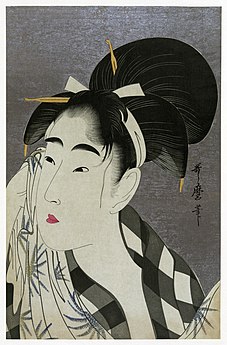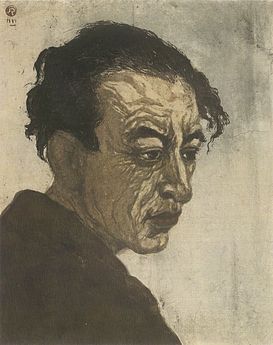Ōkubi-e
Appearance
An ōkubi-e (Japanese: 大首絵) is a Japanese portrait print or painting in the ukiyo-e genre showing only the head or the head and upper torso.[1] Katsukawa Shunkō I (1743–1812) is generally credited with producing the first ōkubi-e. He, along with Katsukawa Shunshō, designed ōkubi-e of male kabuki actors. In the early-1790s, Utamaro designed the first ōkubi-e of beautiful women (bijin-ga ōkubi-e). The shogunate authorities banned ōkubi-e in 1800, but the ban was lifted after eight years.
Gallery
[edit]-
Ōkubi-e of kabuki actor Matsumoto Kōshirō IV as Tsurunosuke, a woodblock print by Katsukawa Shunkō I
-
Woodblock print by Utagawa Kunimasa of kabuki actor Ichikawa Ebizō in a shibaraku role, 1796
-
Ichikawa Yaozo III as Umeōmaru, woodblock print by Utagawa Kunimasa, 1796
-
Nakazō Nakamura II as Edobee, woodblock print by Sharaku, 1794
-
Print by Kitagawa Utamaro
-
Woman Wiping Sweat, woodblock print by Utamaro, 1798
-
Portrait of Hagiwara Sakutarō, woodblock print by Onchi Kōshirō, 1943
References
[edit]Further reading
[edit]- Newland, Amy Reigle. (2005). Hotei Encyclopedia of Japanese Woodblock Prints. Amsterdam: Hotei. ISBN 9789074822657; OCLC 61666175
- Roberts, Laurance P. (1976). A Dictionary of Japanese Artists. New York: Weatherhill. ISBN 9780834801134; OCLC 2005932
- Bell, David (2004). Ukiyo-e explained. Folkestone, Kent: Global Oriental. ISBN 978-19-01-90341-6. Retrieved 17 June 2022.








